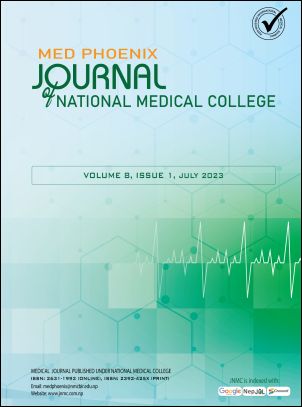Study of Hemoglobin and Calcium Phosphorus Product in Patients with Chronic Kidney Disease
DOI:
https://doi.org/10.3126/medphoenix.v8i1.56928Keywords:
Calcium, Chronic Kidney Disease, Hemoglobin, PhosphorousAbstract
Introduction: Kidneys play a vital role in the metabolism of minerals such as calcium and phosphorous. Moreover, kidney is involved in the production of erythropoietin hormone.The bone marrow suppression may occur in Chronic Kidney Disease (CKD) patients. Reduced hemoglobin and increased calcium phosphorous product concentration is also common in CKD patients.The current study is aimed to find out the impact of CKD in calcium phosphorous product and hemoglobin level in Nepalese population.
Materials And Methods: One hundred consecutive diagnosed cases of CKDpatients were enrolled retrospectively for the study. Calcium, phosphorous, urea, creatinine and other biochemical parameters were measured in fully automated biochemistry analyzer and hemoglobin was measured using hematology analyzer (Beckman Coulter DxH500 Automated Hematology analyzer).
Results: The current study revealed the hemoglobin and calcium phosphorous product in CKD patients.The Calcium Phosphorous Product (CaP) of 69 subjects were having less than <40mg2/dL2 and remaining 31 were having ≥ 40mg2/dL2. The negative correlation of calcium phosphorous product was seen with calcium (r= -0.478, p-value = 0.000) and sodium (r=-0.309, p-value=0.002) whereas positive correlation of calcium phosphorous product was seen with urea (r= 0.559, p-value=0.000) andCreatinine (r=0.353, p-value = 0.000). The creatinine was negatively correlated with the hemoglobin concentration (r= -0.320, p-value = 0.001).
Conclusion: Calcium phosphate product can be fluctuated in chronic kidney disease patients along with the decrement of hemoglobin concentration. The serum calcium phosphorous product measurement can assist to rule out the severity of chronic kidney disease.
Downloads
Downloads
Published
How to Cite
Issue
Section
License
Copyright (c) 2023 Med Phoenix

This work is licensed under a Creative Commons Attribution 4.0 International License.
Copyright on any research article is transferred in full to MED PHOENIX upon publication. The copyright transfer includes the right to reproduce and distribute the article in any form of reproduction (printing, electronic media or any other form).
© MEDPHOENIX
![]()
Articles in the MED PHOENIX are Open Access articles published under the Creative Commons CC BY License (https://creativecommons.org/licenses/by/4.0/). This license permits use, distribution and reproduction in any medium, provided the original work is properly cited.




